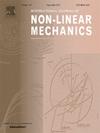A constant quasi-zero stiffness isolator with tension springs to isolate vibrations with ultralow frequency
IF 3.2
3区 工程技术
Q2 MECHANICS
International Journal of Non-Linear Mechanics
Pub Date : 2025-04-26
DOI:10.1016/j.ijnonlinmec.2025.105129
引用次数: 0
Abstract
Many types of quasi-zero stiffness (QZS) isolators have been developed to isolate vibrations with low frequencies. However, isolating vibrations with ultralow frequency as low as 1 Hz is still a great challenge even in laboratory tests due to the high damping of QZS prototypes. To address this issue, a novel isolator with intrinsically light damping is proposed by configurating tension springs and oblique bars. The linear or nonlinear negative stiffness generated by the horizontal tension springs and oblique bars counteracts the linear positive stiffness of the vertical tension springs to obtain the QZS-related features including nonlinear QZS, constant positive or negative dynamic stiffness, constant QZS, and constant zero stiffness. Two QZS conditions are derived and the influence of parameters on QZS is thoroughly studied. The proposed isolator with tension springs has obvious differences from the previous isolator with compression springs in terms of QZS conditions, as well as force and stiffness expressions. Then, the displacement transmissibility is calculated by using the increment harmonic balance method and the continuous arc-length algorithm, which is verified by the classical harmonic balance method. These methods have the same prediction result. Finally, a prototype is fabricated and tested. The smoother force curves with constant QZS and the higher transmissibility amplitude can be obtained in tests compared to the previous isolator with compression springs under the same configuration parameters, which verifies the theoretical formulations of the proposed isolator with light damping. The prototype is further improved by replacing linear bearings with sliders to reduce the frictional effects. As a result, vibrations with ultralow frequencies lower than 1 Hz are successfully isolated. The proposed isolator has a wider frequency band and lower transmissibility than the previous isolator with compression springs. This study offers an effective method of decreasing the large positive stiffness to obtain constant QZS for isolating vibrations with ultralow frequency.
带张力弹簧的恒准零刚度隔振器,可隔离超低频振动
许多类型的准零刚度(QZS)隔振器已经被开发出来以隔离低频振动。然而,即使在实验室测试中,由于QZS原型的高阻尼,隔离低至1hz的超低频率振动仍然是一个巨大的挑战。为了解决这一问题,提出了一种新型的本征轻阻尼隔振器,该隔振器采用张力弹簧和斜杆结构。水平张力弹簧和斜杆产生的线性或非线性负刚度抵消垂直张力弹簧的线性正刚度,从而获得非线性QZS、恒定正或负动刚度、恒定QZS和恒定零刚度等与QZS相关的特性。导出了两种QZS条件,并深入研究了参数对QZS的影响。本文提出的张力弹簧隔振器在QZS条件以及力和刚度表达式方面与以往的压缩弹簧隔振器有明显差异。然后,采用增量谐波平衡法和连续弧长算法计算位移透射率,并用经典谐波平衡法进行验证。这些方法的预测结果是一致的。最后,制作了样机并进行了测试。在相同配置参数下,与以往的压缩弹簧隔振器相比,在QZS恒定的情况下,实验得到的力曲线更平滑,透射率幅值更高,验证了所提轻阻尼隔振器的理论公式。原型通过用滑块替换线性轴承以减少摩擦影响而进一步改进。因此,低于1hz的超低频率振动被成功隔离。与以往的压缩弹簧隔离器相比,该隔离器具有更宽的频带和更低的传输率。该研究提供了一种减小大正刚度以获得恒定QZS以隔离超低频振动的有效方法。
本文章由计算机程序翻译,如有差异,请以英文原文为准。
求助全文
约1分钟内获得全文
求助全文
来源期刊
CiteScore
5.50
自引率
9.40%
发文量
192
审稿时长
67 days
期刊介绍:
The International Journal of Non-Linear Mechanics provides a specific medium for dissemination of high-quality research results in the various areas of theoretical, applied, and experimental mechanics of solids, fluids, structures, and systems where the phenomena are inherently non-linear.
The journal brings together original results in non-linear problems in elasticity, plasticity, dynamics, vibrations, wave-propagation, rheology, fluid-structure interaction systems, stability, biomechanics, micro- and nano-structures, materials, metamaterials, and in other diverse areas.
Papers may be analytical, computational or experimental in nature. Treatments of non-linear differential equations wherein solutions and properties of solutions are emphasized but physical aspects are not adequately relevant, will not be considered for possible publication. Both deterministic and stochastic approaches are fostered. Contributions pertaining to both established and emerging fields are encouraged.

 求助内容:
求助内容: 应助结果提醒方式:
应助结果提醒方式:


